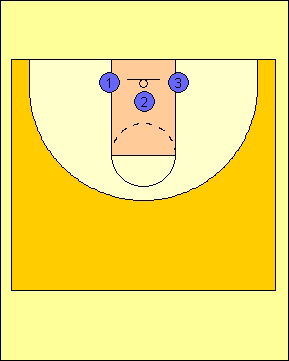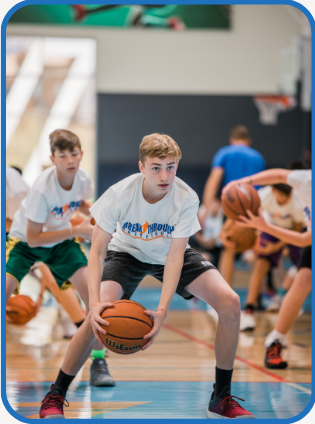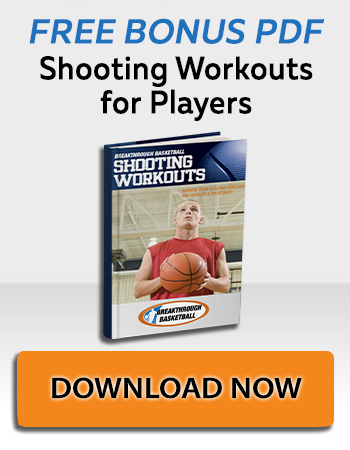Form Shooting Drill
This drill will improve shooting form and develop good shooting habits so once players get in a game, they will consistently use proper form without thinking about it. This simple drill is critical for youth player and can greatly improve shooting percentages for all types of players. All youth coaches should run this drill almost daily.
Instructions
First of all, it's important to understand that this is drill requires you and all your players to pay very close attention to the details. It also requires a lot of repetitions. This is all about developing perfect shooting form, so once you get in a game you use the proper form without even thinking about it.
To get FREE Shooting Workouts, click the banner below
Note: For the first time around, you'll need to demonstrate proper technique to all your players.

- Each player needs to grab a basketball and find a basket. It works best to have three players (or less) at each basket. Two players on each side of the basket and one in front.
- Each player should stand about 2 feet from the basket. (Yes, it's only two feet. Do not stand farther back!)
- For right handed shooters, your right foot should be centered with the basket and pointing directly towards the middle of the basket.
- Your left foot should be positioned shoulder width apart in a comfortable position. Most players leave their left foot slightly behind the other foot. The left foot should be pointing in the relative area of the basket but probably should not be pointing directly at it. Most players feel the most comfortable with their left foot pointing just to the left of the basket.
- Bend your knees, at a comfortable angle somewhere around 45 degrees.
- Now if you're feet are aligned properly, the rest of your body should follow suit.
- Hold the ball in your hand, palm facing up. Your non-shooting hand can dangle to the side.
- Slowly bring the ball in and hold is as if you were shooting with one hand.
- Your arm should form a 90 degree angle.
- Your tricep should be parallel with the floor and directly above your right leg.
- Your wrist should be bent with fingers spread out. The ball should be sitting on your finger pads, NOT your finger tips.
- Your index finger should be in the center of the ball.
- Pause. This is when you make sure your arm, feet, and everything is in the correct form.
- Look at the front of the rim.
- Proceed to shoot with one hand, leaving your off hand to the side. The player should use his legs on every shot. At the end of the shot, the player should be up on his toes. This is very important, because players generate most of their strength from their legs to shoot the ball to the basket.
- Hold your follow through. Tell your players, "It's like reaching into a cookie jar."
- Grab the ball and repeat the process.
- Get the ball quickly but don't hurry your shot! Take your time.
- Each player should get a minimum of 20 repetitions, but 50 or 100 would be better.
As players master this skill, you can progress to other variations:
- Use two hands instead of one. Just make sure the off hand is one the side of the ball and not used to propel the ball.
- Do a jump shot. You should still stay two feet from the basket.
- Flip the ball to yourself, pivot, and shoot a jump shot. Again, stay close to the basket and make sure you proper form, even though you are going slightly faster. Do not sacrifice form!
Points of Emphasis
Continually tell your players...
- Hold your follow through.
- Take your time and always make sure your form is perfect.
- Bend your knees.
- Don't stand back too far! Stay just a couple feet from the basket.
Motivation / Teaching Tips
Tip #1 - Tell you players, "Once you get good at it, don't think you can stop. There are NBA players that do form shooting everyday!"
Tip #2 - Assign a coach to each basket to make sure they are using proper form. Help them correct any problems. If they don't do it properly, this drill is a waste of time.
Tip #3 - Make sure your players do NOT dip one shoulder or lean too far forward. When shooting, you want your players to have an erect torso. I like to use the phrase "shoot tall."
Tip #4 - If you as a coach, don't know all the aspects of proper shooting form, consider picking up a good shooting video. We covered the basics above but there are more things to look for, like hand placement on the ball and so on.
If you're looking to level up your game this year, be sure to check out our Breakthrough Basketball Camps. Led by world-class instuctors, our camps will help you reach the next level! Check out our camps page to find camps near you!
Gain the Edge to
Stand Out on the Court
Breakthrough Basketball Camps help players improve their skills and decision-making while building the confidence to shine on and off the court. Trusted by over 150,000 players nationwide, our camps provide:

-
Experienced coaches who know how to teach every level
-
Skill development in shooting, ball handling, and all-around play
-
Game-like situations that build confidence under pressure
-
A positive, motivating environment parents can feel good about
-
Beginner, Youth, and Advanced Camps - Ages 6 to 18
What do you think? Let us know by leaving your comments, suggestions, and questions...
|
||||||||||||||||||||||||




 Facebook (145k Followers)
Facebook (145k Followers) YouTube (152k Subscribers)
YouTube (152k Subscribers) Twitter (33k Followers)
Twitter (33k Followers) Q&A Forum
Q&A Forum Podcasts
Podcasts